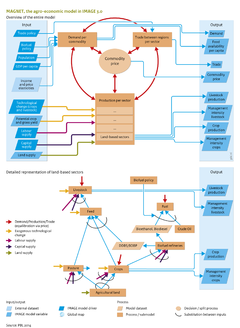Agricultural economy/Description: Difference between revisions
Jump to navigation
Jump to search
No edit summary |
Oostenrijr (talk | contribs) No edit summary |
||
| Line 1: | Line 1: | ||
{{ComponentDescriptionTemplate | {{ComponentDescriptionTemplate | ||
|Reference=Hertel, 1997; Britz, 2003; Armington, 1969; Huang et al., 2004; Helming et al., 2010; Banse et al., 2008; Bruinsma, 2003; Woltjer et al., 2011; Van Meijl et al., 2006; Eickhout et al., 2009; Overmars et al., accepted; Alexandratos and Bruinsma, 2012; | |Reference=Hertel, 1997; Britz, 2003; Armington, 1969; Huang et al., 2004; Helming et al., 2010; Banse et al., 2008; Bruinsma, 2003; Woltjer et al., 2011; Van Meijl et al., 2006; Eickhout et al., 2009; Overmars et al., accepted; Alexandratos and Bruinsma, 2012; | ||
|Description=The MAGNET model ([[Woltjer et al., 2011]]; [[Woltjer et al., 2014]]) is based on the standard GTAP model ([[Hertel, 1997]]), which is a multi-regional, static, applied computable general equilibrium ({{abbrTemplate|CGE}}) model based on neoclassical microeconomic theory. Although the model covers the entire economy, there is a special focus on agricultural sectors. It is a further development of GTAP regarding land use, household consumption, livestock, food, feed and energy crop production, and emission reduction from deforestation. | |Description=The MAGNET model ([[Woltjer et al., 2011]]; [[Woltjer et al., 2014]]) is based on the standard GTAP model ([[Hertel, 1997]]), which is a multi-regional, static, applied computable general equilibrium ({{abbrTemplate|CGE}}) model based on neoclassical microeconomic theory. Although the model covers the entire economy, there is a special focus on agricultural sectors. It is a further development of GTAP regarding land use, household consumption, livestock, food, feed and energy crop production, and emission reduction from deforestation. | ||
| Line 31: | Line 31: | ||
# change in agricultural area affecting crop yields (such as, decreasing average yields due to expansion into less suitable regions; from IMAGE). | # change in agricultural area affecting crop yields (such as, decreasing average yields due to expansion into less suitable regions; from IMAGE). | ||
Biophysical yield effects due to climate and area changes are calculated by the IMAGE crop model and communicated to MAGNET. External assumptions on autonomous technological changes are mostly based on FAO projections ([[Alexandratos and Bruinsma, 2012]]), which describe per region and commodity, the assumed future changes in yields for a wide range of crop types. In MAGNET, the biophysical yield changes are combined with the autonomous technological change to give the total exogenous yield change. In addition, during the simulation period, MAGNET calculates an endogenous intensification as a result of price-driven substitution between labour, land and capital. In IMAGE, regional yield changes due to autonomous technological change and endogenous intensification according to MAGNET are used in the spatially explicit allocation of land use (Component [[Land-use allocation]]). | Biophysical yield effects due to climate and area changes are calculated by the IMAGE crop model and communicated to MAGNET. Likewise, also the potential yields and thus the yield gap can be assessed with the crop model in IMAGE. External assumptions on autonomous technological changes are mostly based on FAO projections ([[Alexandratos and Bruinsma, 2012]]), which describe per region and commodity, the assumed future changes in yields for a wide range of crop types. In MAGNET, the biophysical yield changes are combined with the autonomous technological change to give the total exogenous yield change. In addition, during the simulation period, MAGNET calculates an endogenous intensification as a result of price-driven substitution between labour, land and capital. In IMAGE, regional yield changes due to autonomous technological change and endogenous intensification according to MAGNET are used in the spatially explicit allocation of land use (Component [[Land-use allocation]]). | ||
}} | }} | ||
Revision as of 11:12, 17 June 2014
Parts of Agricultural economy/Description
| Component is implemented in: |
|
| Related IMAGE components |
| Projects/Applications |
| Key publications |
| References |
